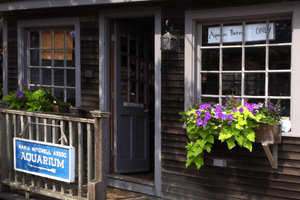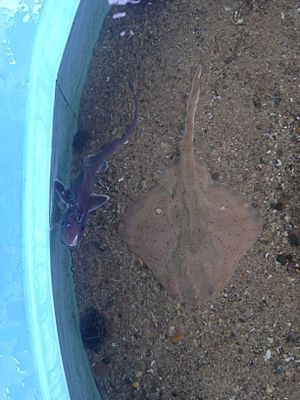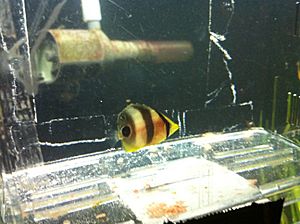Maria Mitchell Aquarium facts for kids

Exterior of the Maria Mitchell Aquarium Gift Shop, July 2012
|
|
| Date opened | 1997 |
|---|---|
| Location | Nantucket, Massachusetts, USA |
| Coordinates | 41°16′55″N 70°05′45″W / 41.2819°N 70.0959°W |
| No. of animals | 50+ |
| No. of species | 50+ |
| Annual visitors | 7,000 |
| Memberships | 700 + (of Maria Mitchell Association) |
The Maria Mitchell Association Aquarium, also called the Nantucket Aquarium, is a small, seasonal aquarium in Nantucket, Massachusetts. It's the only place on the island focused on marine science. The Aquarium is part of the Maria Mitchell Association. This group teaches about science and does research. They honor Maria Mitchell (1818-1889), who was America's first female astronomer and grew up in Nantucket.
Contents
About the Maria Mitchell Aquarium
The Maria Mitchell Aquarium is located at 28 Washington Street. This spot used to be the ticket office for the old Nantucket Railroad. It sits right on the edge of Nantucket Harbor. The harbor connects to the Nantucket Sound. Most of the animals at the aquarium are caught from the waters around Nantucket. They are released back into the ocean when the summer season ends.
The aquarium is one of the newer parts of the Maria Mitchell Association. It's one of only two places owned by the Association that is not on their main campus. The aquarium is downtown to make it easier for more people to visit. It is also closer to the harbor, which is helpful for getting animals.
The aquarium has been in the same spot since 1997. It started as just one small room. Over time, it grew to include three rooms and two outdoor touch tanks.
Plans for a New Science Center
A few years ago, the leaders of the Maria Mitchell Association planned to make the aquarium much bigger. The idea was to move it across the street. This new location was traded with the Nantucket Land Bank in 2010. The Land Bank wanted to open up Nantucket Harbor more for everyone.
One big plan for the new site was to build a special domed theater. This idea caused some discussion among people in Nantucket. Especially the Historic District Commission (HDC) had questions about it. In March 2013, the project, which would cost about $10 million, was approved by the HDC. They asked for only small changes.
Some people, like Kevin Kuester from the HDC, were strongly against the project. He felt it was a big mistake. However, many local businesses and groups supported the plan. About 30 local people came to the meeting in 2013 to show their support.
Janet Schulte, who was the Director of the Maria Mitchell Association at the time, explained why a new center was needed. She said that they could only do field trips when the weather was good. A new center would allow science to be taught all year long. The Association hoped to start building in September 2013. However, they couldn't get enough money, so the project was put on hold. It has not happened since then.
What You Can See at the Aquarium
The aquarium has 20 saltwater tanks and two "touch tanks." These are spread across three small buildings. The tanks hold local sea creatures. These animals are returned to the wild when the aquarium closes for winter. The touch tanks let you get close to local animals. You can gently touch crabs, Horseshoe crabs, and clams.
Fun Touch Tanks

A popular part of the aquarium is the touch tank. It is near the small gift shop. This tank is home to crabs, fish (like flounder), shrimp, clams, and snails. You might even see a large, hunting snail called a moon snail.
Other Cool Exhibits
The aquarium offers free personal tours from its staff. They focus on animals found only in local waters. Some special animals you might see include a very large American lobster and a rare blue lobster. The blue color is from an unusual change in its shell. You might also see a common octopus and lined seahorses.
Other local favorites often on display are American eels, the dusky smooth-hound (a type of small shark), and sea robins. The animals on display often change. This is because the aquarium staff add new animals they find.
The biggest tank at the aquarium holds 400 gallons of water. There is also a larger outdoor tank that looks out over Nantucket Harbor. This round outdoor tank often holds bigger fish like scup and black sea bass. It also houses small sharks called smooth dogfish. Other rooms have tanks for trigger fish, lobsters, mantis shrimp, and tropical fish.
Sometimes, you can even see tropical fish like French angelfish, groupers, butterflyfish, and damselfish. This is because the Gulf Stream ocean current passes by the island.
Research at the Aquarium
The aquarium helps with important research projects. They study bay scallops with the Nantucket Shellfish Association. They also look at the different kinds of marine fish and invertebrates. And they take part in the yearly Horseshoe Crab Survey.
Bay Scallop Research
One main research project is about the Bay Scallop. Nantucket Bay Scallops are very important to the island's economy. They bring in about two million dollars each year. People hunt them for food, especially for the muscle that holds their shells together.
Since 2003, the Maria Mitchell Association and Nantucket Shellfish Association have worked together. They count the number of bay scallops in Nantucket Harbor. They use special lines to collect scallops of all ages. This project helps them understand how many scallops are in the water.
Horseshoe Crab Survey
The aquarium also helps with the yearly Nantucket Horseshoe Crab Survey. In early summer, usually from May to June, the aquarium staff watch for Horseshoe Crabs. They count how many are mating in certain areas around the island.
Studying Marine Life Diversity
The Maria Mitchell Aquarium offers daily trips in the summer to collect marine animals. These trips are open to the public for a fee. The goal is to teach people and to count the different kinds of sea creatures in Nantucket's waters.
Here are the top six most common species found in Nantucket's waters:
| Species | How Common It Is | |
|---|---|---|
| 1 | Atlantic silverside | Found in the highest numbers, but only at certain times of the year. |
| 2 | Black-fingered mud crab | The most commonly found species, second most in total numbers. |
| 3 | Northern pipefish | Second most commonly caught, third most in total numbers. |
| 4 | Four-spine stickleback | Very common all year round. |
| 5 | Shore shrimp | Both common and found in large numbers. |
| 6 | Striped killifish | Found in large groups. |
Since this project started in the early 2000s, the Maria Mitchell Aquarium has collected about 56,347 individual animals. These include fish, crabs, snails, and shrimp. They represent 104 different kinds of marine species.
Learning and Fun Programs
The aquarium offers many programs for visitors. These include Marine Ecology Field Trips, Family Snorkeling Tours, Beach Discovery Field Trips, Night Marine Ecology Field Trips, Whale Watches, and Seal Cruises.
Marine Ecology Field Trips

These trips are part of the aquarium's biodiversity project. They also help the staff collect animals for the exhibits. Marine Field Trips are open to everyone, but there is a fee to join. During these trips, a special net called a seine net is used to catch animals in the eelgrass beds.
There are different types of marine field trips. These include daily Marine Ecology Field Trips, Family Snorkeling Tours, Beach Discovery Field Trips, and Night Marine Ecology Field Trips.
"Feeding Frenzy"
The "Feeding Frenzy" is a daily program in the summer. During this time, the aquarium staff feed the animals. Visitors who pay a special fee can watch this exciting event.
Whale and Seal Watching Tours
The Maria Mitchell Aquarium works with a local tour company called Shearwater Excursions. In the summer, they lead boat tours of the harbor and ocean. On these trips, you can see marine mammals like seals and whales. The Seal Cruise takes people to nearby Muskeget Island to see grey seals.
See also
 In Spanish: Acuario Maria Mitchell para niños
In Spanish: Acuario Maria Mitchell para niños


